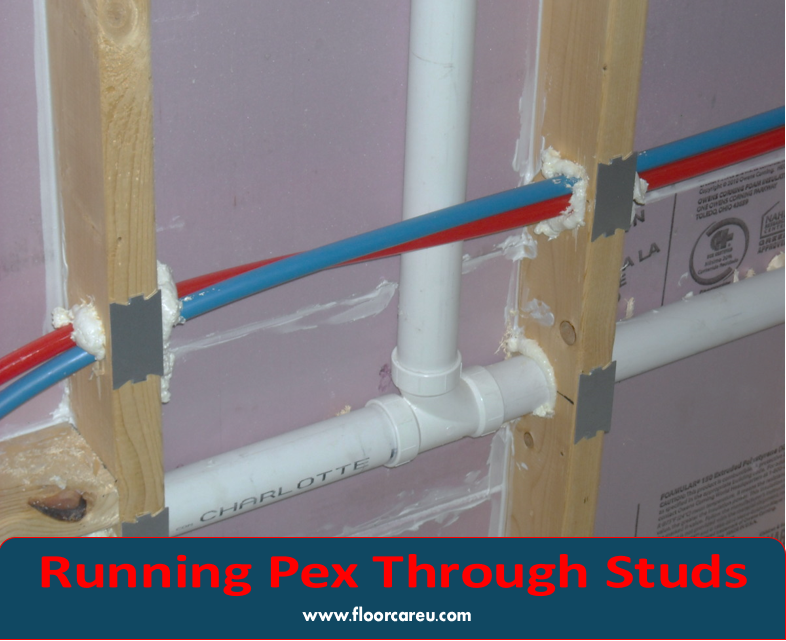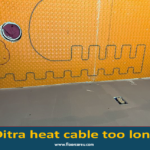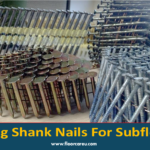Running Pex Through Studs: Running Pex through studs is possible and does not require any special protection. However, installing nail plates on the front of the studs is recommended to prevent any potential damage to the Pex pipe.
This can be done by drilling holes for Pex installation and using abrasion clips to secure the Pex pipe around the studs. Following these steps, you can safely run Pex through wood studs without issues.

Tools And Materials
When running Pex through studs for your plumbing project, it’s essential to have the right tools and materials. This section will discuss the tools you need to ensure a smooth installation process. Additionally, we will recommend materials suitable for running Pex through studs. Let’s dive in!
Essential Tools
Here are the essential tools you will need for running Pex through studs:
- Pex Tubing Cutter: A Pex tubing cutter is necessary for cutting the Pex tubing to the desired length. It provides clean and precise cuts.
- Drill with a Hole Saw Attachment: You’ll need a drill with a hole saw attachment to create holes in the studs for passing the Pex tubing through. Ensure the hole saw attachment matches the size of your Pex tubing.
- Pex Crimping Tool: A Pex crimping tool secures the Pex tubing to fittings, ensuring a secure and leak-free connection.
- Tape Measure: A tape measure will help you accurately measure the length of Pex tubing required for your project.
- Pencil or Marker: Use a pencil or marker to mark the locations where you need to drill holes in the studs.
- Protective Eyewear: Safety should always be a priority. Wear eyewear to protect your eyes from potential debris while drilling holes.
Recommended Materials
Here are some recommended materials for running Pex through studs:
| Materials | Description |
|---|---|
| Pex Tubing: | Purchase high-quality Pex tubing suitable for your specific plumbing needs. Ensure it meets the necessary standards and has the required certifications. |
| Pex Fittings: | Choose Pex fittings that are compatible with your Pex tubing. Consider using brass or stainless steel fittings for durability and longevity. |
| Nail Plates: | To protect the Pex tubing from any potential damage, use nail plates on the front of the studs. These plates provide an extra layer of protection against accidental punctures. |
Preparing For Installation
Before running PEX through studs, preparing for the installation process is crucial. This involves assessing the wall structure and determining the PEX route to ensure a smooth and efficient installation.
Assessing Wall Structure
- Check the layout of the wall studs to identify potential obstacles or challenges.
- Ensure there are no electrical wires or other utilities in the path of the PEX route.
- Measure the distance between studs to determine the length of PEX tubing needed.
Determining Pex Route
- Create a plan for the PEX route, considering the shortest and most direct path.
- Mark the locations where the PEX tubing will run through the studs.
- Ensure the PEX route allows for easy access and maintenance in the future.
By carefully assessing the wall structure and determining the PEX route, you can ensure a successful installation process without any setbacks.
Drilling Techniques
Efficient drilling techniques are essential for running PEX through studs in plumbing installations. Proper support and protection ensure smooth passage for PEX tubing through wood studs in residential and commercial projects. Using abrasion clips securely around the PEX helps maintain integrity during installation.
Choosing The Right Drill Bit
To start drilling PEX through studs, selecting the proper drill bit is crucial. Opt for a sharp, high-speed steel bit that matches the diameter of the PEX tubing.
Minimizing Friction And Damage
By aligning the drill bit perpendicularly, you reduce the risk of friction and damage. Employ gentle and consistent pressure while drilling to maintain the integrity of the PEX.
Protective Measures
Running PEX through studs is a common practice in plumbing installations. By properly protecting the PEX tubing when it passes through the studs, you can ensure the durability and longevity of your plumbing system. There are various methods and tools available to secure and support the PEX tubing, such as using nail plates or abrasion clips, to prevent any damage or wear over time.
Using Abrasion Clips
When running Pex through wood studs, it is important to take protective measures to prevent damage to the tubing. One effective method is to use abrasion clips. These clips provide an additional layer of protection, ensuring that the Pex tubing is securely held in place and is not at risk of rubbing against any sharp edges or rough surfaces. Using abrasion clips is a simple and cost-effective solution that can save you from potential problems down the line. These clips are designed to be easily installed onto the studs, creating a secure pathway for the Pex tubing. By utilizing these clips, you can minimize the risk of abrasion damage and ensure the longevity of your Pex system.
Nail Plate Installation
Another important protective measure when running Pex through studs is nail plate installation. Pex tubing is flexible and can be easily damaged if it comes into contact with nails or screws used to secure the studs. Nail plates act as a barrier between the Pex tubing and the fasteners, preventing any potential punctures or leaks. To install nail plates, position them over the studs where the Pex tubing will run. Make sure to place them at locations where nails or screws are likely to be driven. The nail plates can be secured to the studs using screws or nails, ensuring that they stay in place and provide the necessary protection for the Pex tubing.
By installing nail plates, you can ensure that your Pex system remains intact and free from any damage or leaks. This simple yet effective measure adds extra protection to your Pex installation, giving you peace of mind knowing that your system is secure. In conclusion, when running Pex through studs, it is essential to implement protective measures to safeguard the tubing. Using abrasion clips and installing nail plates are two effective methods to prevent damage and ensure the longevity of your Pex system. Taking these precautions allows you to enjoy the benefits of a reliable and efficient Pex installation without any worries.
Addressing Common Concerns
When installing Pex through studs, it’s crucial to ensure proper support and protection to maintain the integrity of the tubing. Use nail plates on the front of wood studs and consider abrasion clips to secure Pex around corners. Running Pex through joists or steel studs demands careful consideration to prevent potential damage or abrasion.
Running Pex Through Corners
Running PEX through corners can often raise concerns about potential kinking, abrasion, and fittings. It’s important to remember that proper fastening and support must be considered. Implementing appropriate fastening methods, such as using abrasion clips or securing the PEX around corners, can help prevent damage and ensure longevity.
Pex Through Wood Vs. Steel Studs
When running PEX through wood studs, it’s crucial to use nail plates to guard against potential puncturing from screws or nails. However, when running PEX through steel studs, ensure proper protection to prevent abrasion and maintain the integrity of the piping system. Using suitable protective measures is essential for the durability and functionality of the PEX installation.
Addressing concerns when running PEX through studs involves considering potential challenges and implementing appropriate solutions. By addressing common concerns such as PEX through corners and the variation between wood and steel studs, it’s possible to ensure a reliable and durable PEX installation.

Optimizing Performance
Certainly! Running Pex through studs requires careful planning to avoid abrasion or damage. Using abrasion clips securely is essential to protect the Pex from any potential friction. Properly securing the Pex will help maintain its performance and longevity within the studs.
Running Pex through studs optimizes performance by ensuring a consistent and efficient water supply system. It’s essential to maintain water tightness and maximize longevity for seamless operation.
Maintaining Water Tightness
Securing Pex tubing through studs using appropriate fastening methods is crucial for maintaining water tightness. Carefully sealing entry and exit points can also prevent leaks or water damage.
Maximizing Longevity
Maximizing longevity involves protecting the Pex tubing from potential wear and tear as it passes through the studs. Using abrasion clips securely around the Pex can minimize the risk of damage, ensuring a durable and long-lasting installation. In addition, ensure that the Pex tubing is well-supported and protected from any sharp edges or surfaces that may compromise its integrity, especially when running the tubing around corners or through walls.
Investing in proper installation techniques and protective measures maximizes the longevity of the Pex system and ensures its reliable performance over time.
Frequently Asked Questions Of Running Pex Through Studs
Does Pex Need To Be Protected Through Studs?
No, PEX does not need to be protected through studs. It can run through wood studs and joists without any issues. However, nail plates on the front of the studs are recommended to avoid potential damage to the PEX pipe.
Can You Run Pex Through Wood?
Yes, you can run PEX through wood. Use abrasion clips around PEX to secure it properly.
Can You Run Pex Through Walls?
Yes, you can run PEX through walls without issues. For extra security, protect it with abrasion clips around bends.
Can You Run Pex Through Joists?
Yes, you can run PEX through joists. PEX (cross-linked polyethylene) is a flexible and durable material commonly used for plumbing in residential and commercial construction. It is okay to run PEX through floor joists without any issues.
Q1: Can Pex Tubing Run Through Wood Studs?
PEX tubing can run through wood studs with protection.
Q2: Is It Safe To Run Pex Through Walls?
Running PEX through walls is a safe practice.
Q3: Can Pex Be Run Through Floor Joists?
Yes, PEX can be safely run through floor joists.
Conclusion
Running Pex through studs is a common and efficient practice in plumbing installation. It provides proper support for long runs of Pex tubing and allows for easy routing through walls and floors. While it is important to protect the Pex pipe in areas where it bends, there is no need for additional measures when running it through wood studs.
By following proper installation guidelines, such as using nail plates on the front of the studs, homeowners can ensure a successful Pex installation without compromising the integrity of their walls or floors.


